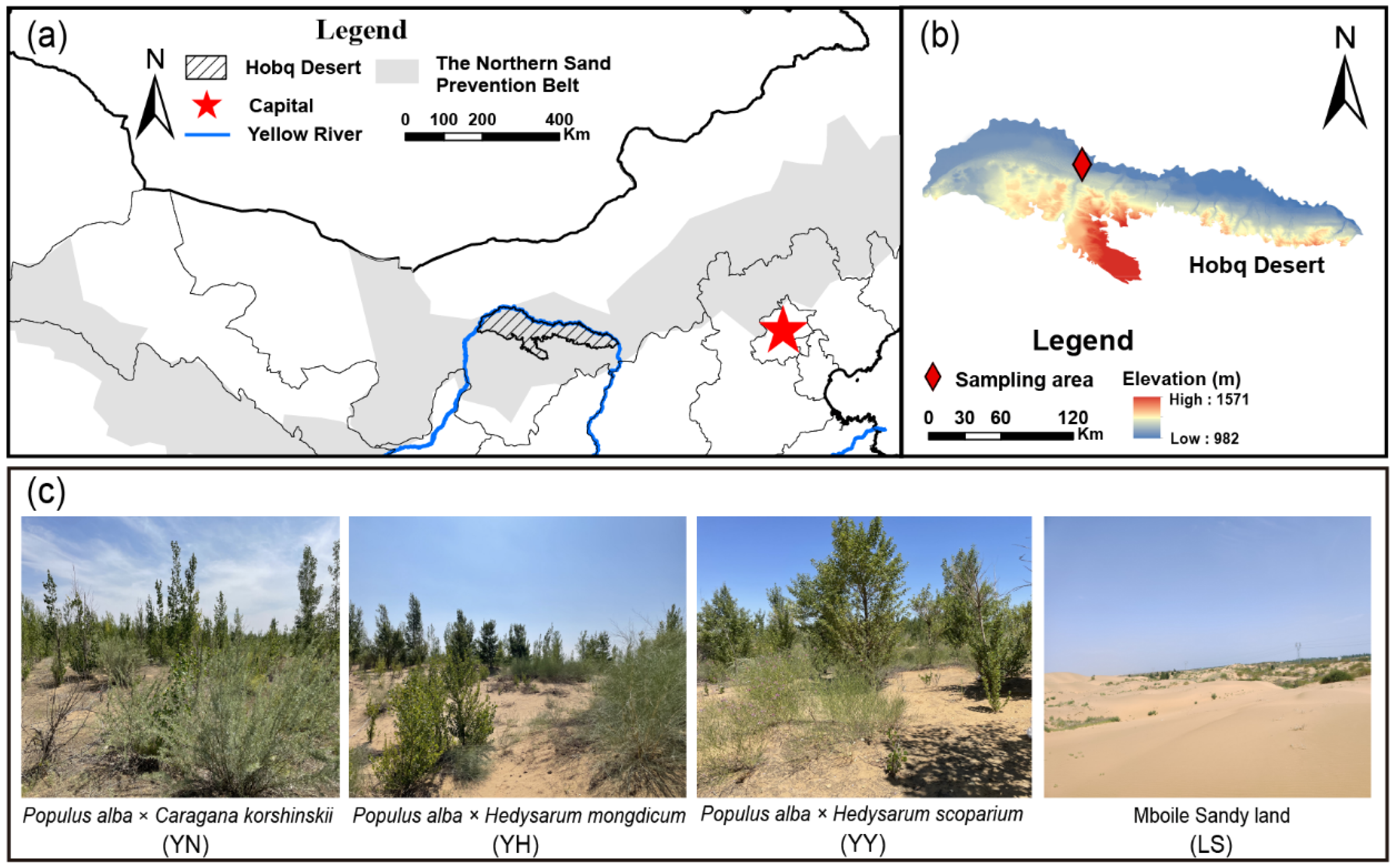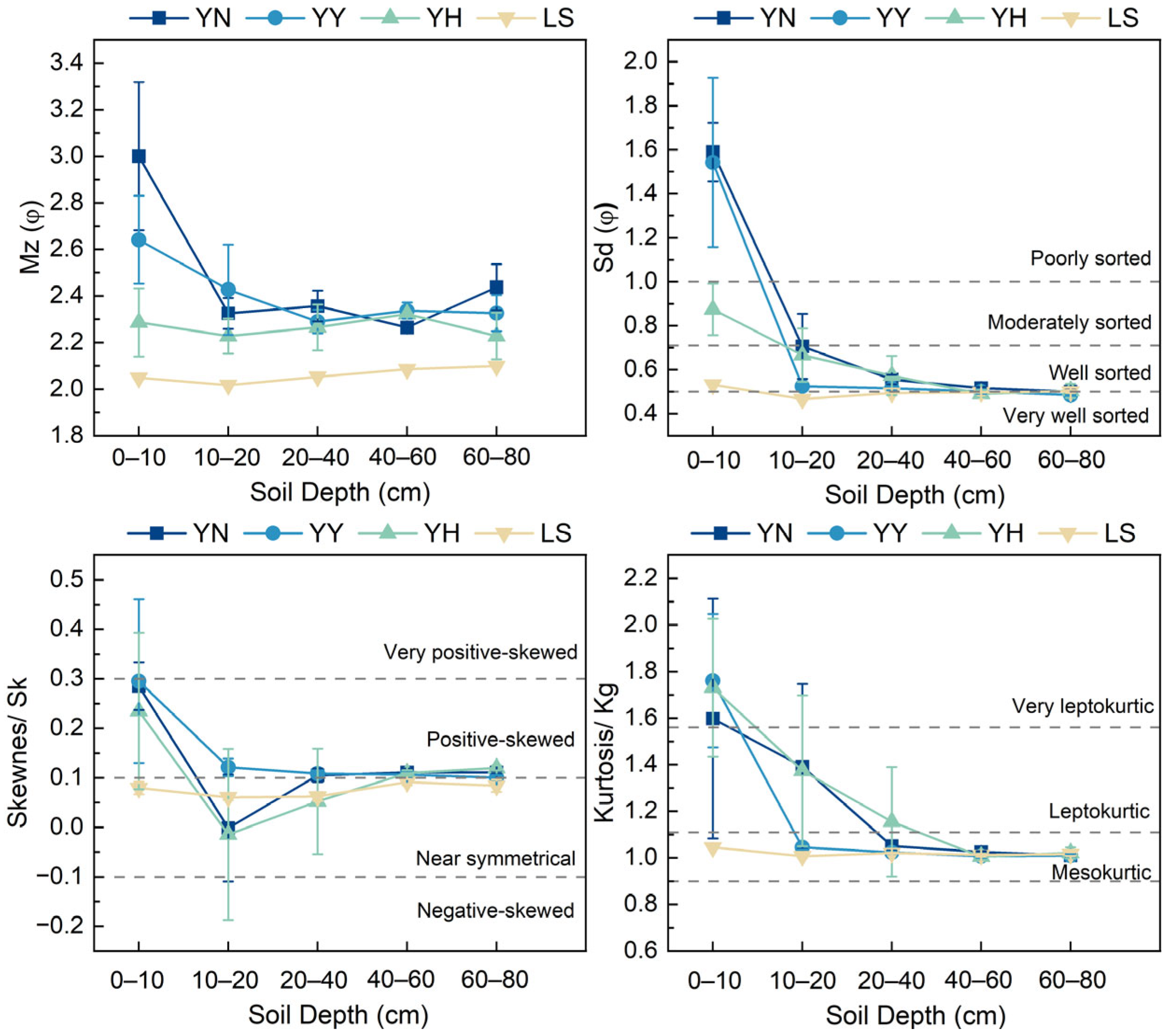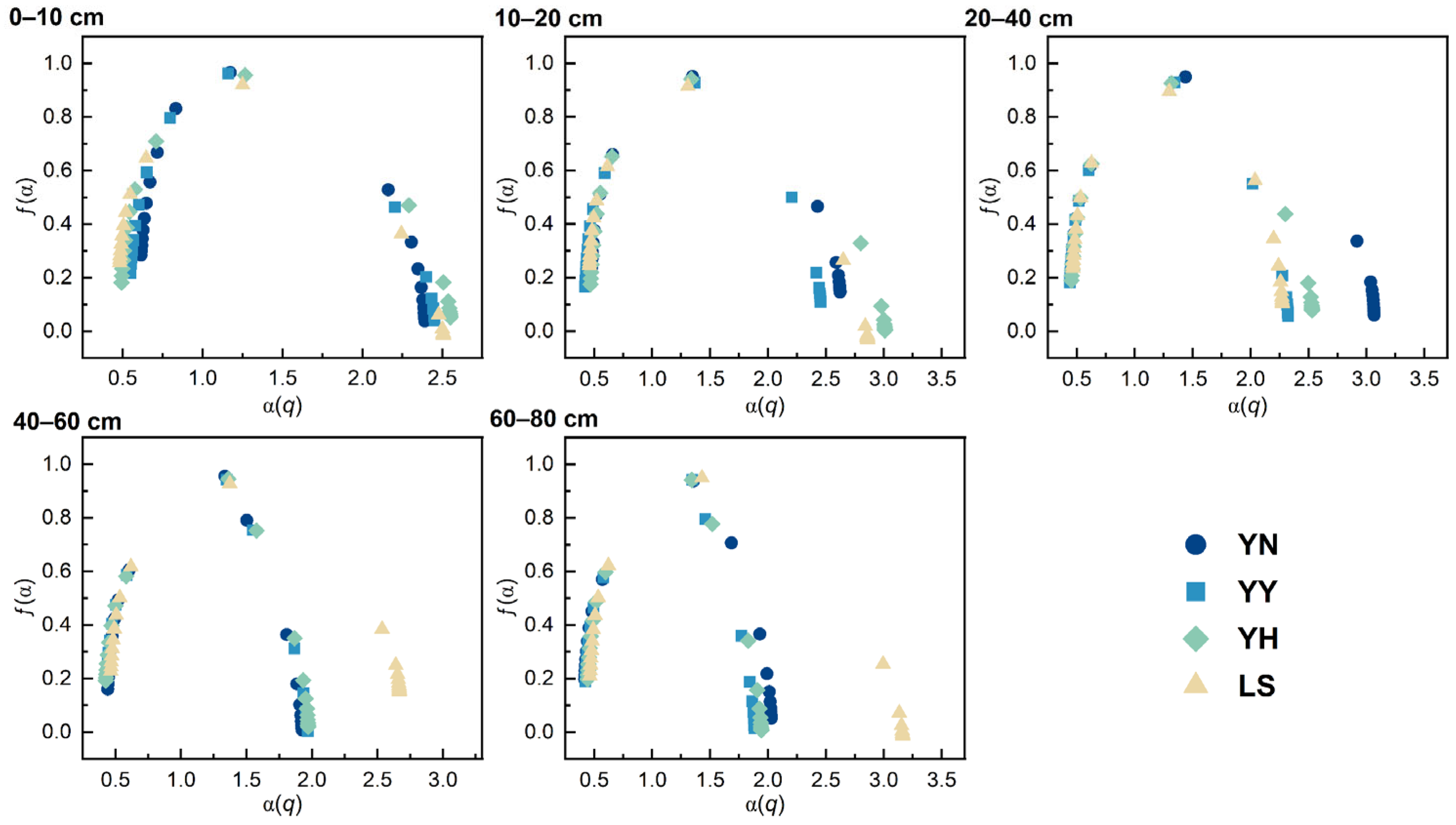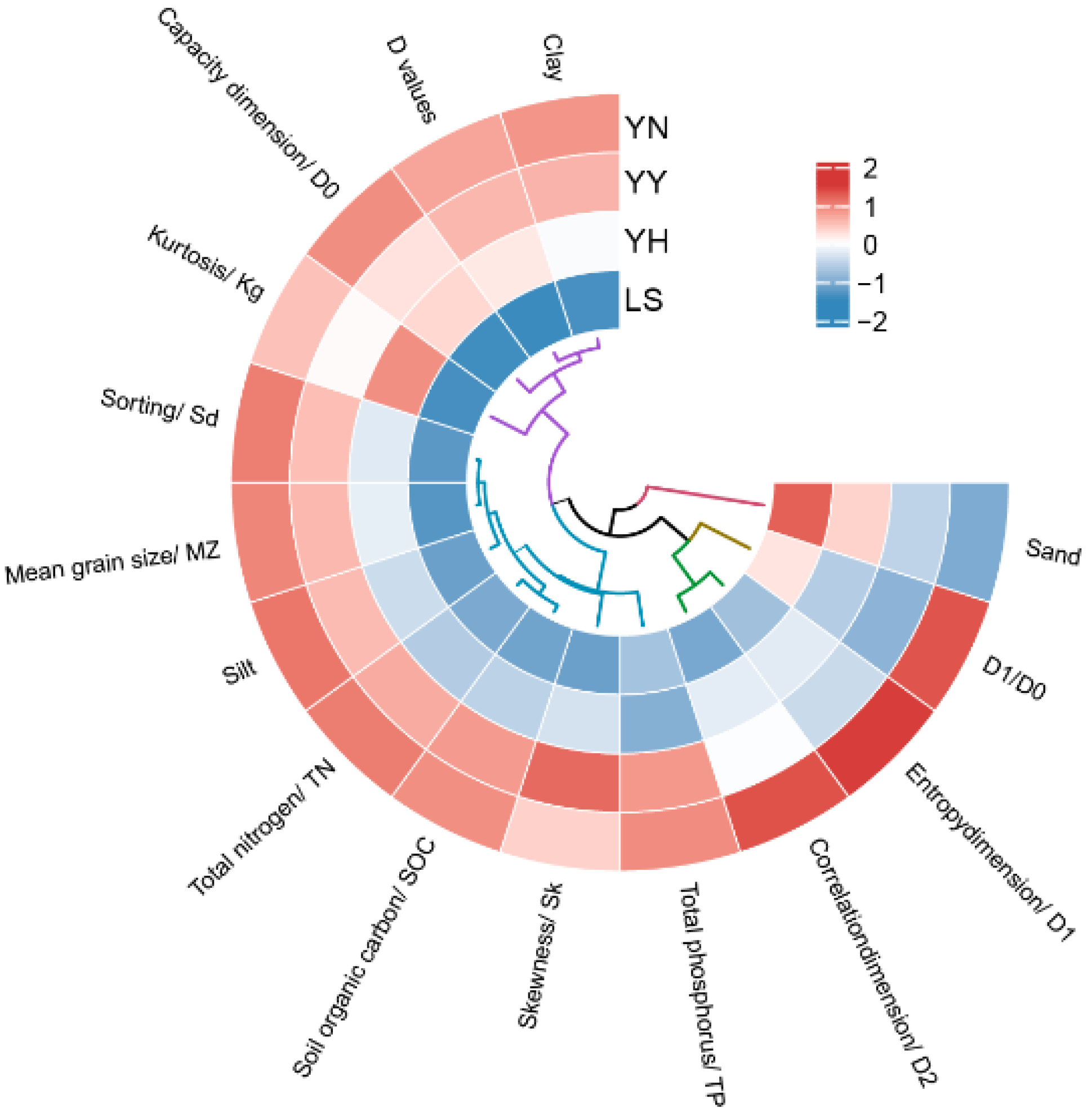Characteristics of Soil Particle Sizes and Fractal Parameters under Different Plantation Types of Populus alba
Abstract
:1. Introduction
2. Materials and Methods
2.1. Investigation Status of the Study Area
2.2. Sample Plot Survey and Soil Sample Collection
2.3. Determination of Physiochemical Properties of Soil
2.4. Calculation of Soil Particle Size Parameters
2.5. Calculation of Soil Fractal Dimensions and Multifractal Parameters
2.5.1. Calculation of Soil Fractal Dimension (D) Values
2.5.2. Soil Multifractal Parameter Modeling
2.6. Statistical Analyses
3. Results
3.1. Soil Nutrient Distribution under Different Types of Plantations
3.2. Distribution of Soil Particle Composition and Size Parameters under Different Types of Plantations
3.3. Distribution of D Values and Multifractal Parameters under Different Types of Plantations
3.4. Relationships between D Values, Multifractal Parameters, Particle Size Parameters, and Environmental Factors
4. Discussion
5. Conclusions
Author Contributions
Funding
Data Availability Statement
Conflicts of Interest
References
- Jiang, Z.; Ni, X.; Xing, M. A Study on Spatial and Temporal Dynamic Changes of Desertification in Northern China from 2000 to 2020. Remote Sens. 2023, 15, 1368. [Google Scholar] [CrossRef]
- D’Odorico, P.; Bhattachan, A.; Davis, K.F.; Ravi, S.; Runyan, C.W. Global desertification: Drivers and feedbacks. Adv. Water Resour. 2013, 51, 326–344. [Google Scholar] [CrossRef]
- Ma, S.; Wang, H.-Y.; Wang, L.-J.; Jiang, J.; Gong, J.-W.; Wu, S.; Luo, G.-Y. Evaluation and simulation of landscape evolution and its ecological effects under vegetation restoration in the northern sand prevention belt, China. Catena 2022, 218, 106555. [Google Scholar] [CrossRef]
- Zhai, J.; Wang, L.; Liu, Y.; Wang, C.; Mao, X. Assessing the effects of China’s Three-North Shelter Forest Program over 40 years. Sci. Total Environ. 2023, 857, 159354. [Google Scholar] [CrossRef] [PubMed]
- Mirzabaev, A.; Sacande, M.; Motlagh, F.; Shyrokaya, A.; Martucci, A. Economic efficiency and targeting of the African Great Green Wall. Nat. Sustain. 2021, 5, 17–25. [Google Scholar] [CrossRef]
- Romero-Diaz, A.; Belmonte-Serrato, F.; Ruiz-Sinoga, J.D. The geomorphic impact of afforestations on soil erosion in Southeast Spain. Land Degrad. Dev. 2010, 21, 188–195. [Google Scholar] [CrossRef]
- Ren, M.; Chen, W.; Wang, H. Ecological Policies Dominated the Ecological Restoration over the Core Regions of Kubuqi Desert in Recent Decades. Remote Sens. 2022, 14, 5243. [Google Scholar] [CrossRef]
- Zhang, Z.; Huisingh, D. Combating desertification in China: Monitoring, control, management and revegetation. J. Clean. Prod. 2018, 182, 765–775. [Google Scholar] [CrossRef]
- Sankey, J.B.; Germino, M.J.; Benner, S.G.; Glenn, N.F.; Hoover, A.N. Transport of biologically important nutrients by wind in an eroding cold desert. Aeolian Res. 2012, 7, 17–27. [Google Scholar] [CrossRef]
- Ravi, S.; D’Odorico, P.; Okin, G.S. Hydrologic and aeolian controls on vegetation patterns in arid landscapes. Geophys. Res. Lett. 2007, 34, L24S23. [Google Scholar] [CrossRef]
- Gonzales, H.B.; Ravi, S.; Li, J.; Sankey, J.B. Ecohydrological implications of aeolian sediment trapping by sparse vegetation in drylands. Ecohydrology 2018, 11, e1986. [Google Scholar] [CrossRef]
- Gan, D.; Feng, J.; Han, M.; Zeng, H.; Zhu, B. Rhizosphere effects of woody plants on soil biogeochemical processes: A meta-analysis. Soil Biol. Biochem. 2021, 160, 108310. [Google Scholar] [CrossRef]
- Li, W.; Li, Y.; Lv, J.; He, X.; Wang, J.; Teng, D.; Jiang, L.; Wang, H.; Lv, G. Rhizosphere effect alters the soil microbiome composition and C, N transformation in an arid ecosystem. Appl. Soil Ecol. 2022, 170, 04296. [Google Scholar] [CrossRef]
- Wu, W.; Chen, G.; Meng, T.; Li, C.; Feng, H.; Si, B.; Siddique, K.H.M. Effect of different vegetation restoration on soil properties in the semi-arid Loess Plateau of China. Catena 2023, 220, 106630. [Google Scholar] [CrossRef]
- Zhang, J.; Zhang, C.; Zhou, N.; Ma, X. Spatial pattern of grain-size distribution in surface sediments as a result of variations in the aeolian environment in China’s Shapotou railway protective system. Aeolian Res. 2011, 3, 295–302. [Google Scholar] [CrossRef]
- Wadhawan, S.K.; Kumar, P. Depositional environment in Great Indian Desert using grain size parameters and its chemical characterization. J. Geol. Soc. India 2016, 88, 120–121. [Google Scholar] [CrossRef]
- Miri, A.; Webb, N.P. The impact of a multiple-row Tamarix windbreak on grain size parameters of aeolian sand flux. Soil Sci. Soc. Am. J. 2024, 88, 482–497. [Google Scholar] [CrossRef]
- Webb, N.P.; LeGrand, S.L.; Cooper, B.F.; Courtright, E.M.; Edwards, B.L.; Felt, C.; Van Zee, J.W.; Ziegler, N.P. Size Distribution of Mineral Dust Emissions from Sparsely Vegetated and Supply-Limited Dryland Soils. J. Geophys. Res. Atmos. 2021, 126, e2021JD035478. [Google Scholar] [CrossRef]
- Li, H.; Meng, Z.; Dang, X.; Yang, P. Soil Properties under Artificial Mixed Forests in the Desert-Yellow River Coastal Transition Zone, China. Forests 2022, 13, 1174. [Google Scholar] [CrossRef]
- Sun, C.; Liu, G.; Xue, S. Natural succession of grassland on the Loess Plateau of China affects multifractal characteristics of soil particle-size distribution and soil nutrients. Ecol. Res. 2016, 31, 891–902. [Google Scholar] [CrossRef]
- Feng, X.; Qu, J.; Tan, L.; Fan, Q.; Niu, Q. Fractal features of sandy soil particle-size distributions during the rangeland desertification process on the eastern Qinghai-Tibet Plateau. J. Soils Sediments 2019, 20, 472–485. [Google Scholar] [CrossRef]
- Li, H.; Dang, X.; Han, Y.; Qi, S.; Meng, Z. Sand-fixing measures improve soil particle distribution and promote soil nutrient accumulation for desert—Yellow River coastal ecotone, China. Ecol. Indic. 2023, 157, 111239. [Google Scholar] [CrossRef]
- Rouhi-Moghaddam, E.; Hosseini, S.M.; Ebrahimi, E.; Tabari, M.; Rahmani, A. Comparison of growth, nutrition and soil properties of pure stands of Quercus castaneifolia and mixed with Zelkova carpinifolia in the Hyrcanian forests of Iran. For. Ecol. Manag. 2008, 255, 1149–1160. [Google Scholar] [CrossRef]
- Yevtushenko, D.P.; Misra, S. Enhancing disease resistance in poplar through modification of its natural defense pathway. Plant Mol. Biol. 2019, 100, 481–494. [Google Scholar] [CrossRef] [PubMed]
- Zheng, Y.; Jiang, L.; Gao, Y.; Chen, X.; Luo, G.; Feng, X.; Yu, Y.; An, P.; Yu, Y.; Shimizu, H. Persistence of four dominant psammophyte species in central Inner Mongolia of China under continual drought. J. Arid Land 2013, 5, 331–339. [Google Scholar] [CrossRef]
- Pretzsch, H.; Bielak, K.; Block, J.; Bruchwald, A.; Dieler, J.; Ehrhart, H.-P.; Kohnle, U.; Nagel, J.; Spellmann, H.; Zasada, M.; et al. Productivity of mixed versus pure stands of oak (Quercus petraea (Matt.) Liebl. and Quercus robur L.) and European beech (Fagus sylvatica L.) along an ecological gradient. Eur. J. For. Res. 2013, 132, 263–280. [Google Scholar] [CrossRef]
- Dieler, J.; Pretzsch, H. Morphological plasticity of European beech (Fagus sylvatica L.) in pure and mixed-species stands. For. Ecol. Manag. 2013, 295, 97–108. [Google Scholar] [CrossRef]
- Lebourgeois, F.; Gomez, N.; Pinto, P.; Mérian, P. Mixed stands reduce Abies alba tree-ring sensitivity to summer drought in the Vosges mountains, western Europe. For. Ecol. Manag. 2013, 303, 61–71. [Google Scholar] [CrossRef]
- Forrester, D.I. The spatial and temporal dynamics of species interactions in mixed-species forests: From pattern to process. For. Ecol. Manag. 2014, 312, 282–292. [Google Scholar] [CrossRef]
- Eslaminejad, P.; Heydari, M.; Kakhki, F.V.; Mirab-balou, M.; Omidipour, R.; Muñoz-Rojas, M.; Lucas-Borja, M.E. Plant species and season influence soil physicochemical properties and microbial function in a semi-arid woodland ecosystem. Plant Soil 2020, 456, 43–59. [Google Scholar] [CrossRef]
- Moukoumi, J.; Farrell, R.E.; Van Rees, K.J.C.; Hynes, R.K.; Bélanger, N. Intercropping Caragana arborescens with Salix miyabeana to Satisfy Nitrogen Demand and Maximize Growth. BioEnergy Res. 2012, 5, 719–732. [Google Scholar] [CrossRef]
- Tang, G.-d.; Meng, Z.-j.; Gao, Y.; Dang, X.-h. Wind-sand movement characteristics and erosion mechanism of a solar photovoltaic array in the middle of the Hobq Desert, Northwestern China. J. Mt. Sci. 2021, 18, 1340–1351. [Google Scholar] [CrossRef]
- Dang, X.; Na, Y.; Chi, W.; Zhao, J.; Zhao, Y.; Wang, Y.; Wu, X.; Wang, Y. Spatio-Temporal Evolution of Sandy Land and its Impact on Soil Wind Erosion in the Kubuqi Desert in Recent 30 Years. Front. Environ. Sci. 2022, 10, 950196. [Google Scholar] [CrossRef]
- Vdović, N.; Pikelj, K.; Jurina, I.; Ivanić, M.; Dunato, N.; Štefan, A. The implications of sample preparation on the particle size distribution of soil. J. Plant Nutr. Soil Sci. 2019, 182, 277–285. [Google Scholar] [CrossRef]
- Wentworth, C.K. A Scale of Grade and Class Terms for Clastic Sediments. J. Geol. 1922, 30, 377–392. [Google Scholar] [CrossRef]
- Folk, R.L.; Ward, W.C. Brazos River bar [Texas]; a study in the significance of grain size parameters. J. Sediment. Res. 1957, 27, 3–26. [Google Scholar] [CrossRef]
- Friedman, G.M.; Sanders, J.E. Principles of Sedimentology; Wiley: New York, NY, USA, 1978. [Google Scholar]
- Ma, X.; Xiao, J.; Yao, Z. A comparative study on the three calculation methods of grain-size parameters for aeolian sediments. J. Desert Res. 2020, 40, 95–102. [Google Scholar] [CrossRef]
- Tyler, S.W.; Wheatcraft, S.W. Fractal Scaling of Soil Particle Size Distributions Analysis and Limitations. Soil Sci. Soc. Am. J. 1992, 56, 362–369. [Google Scholar] [CrossRef]
- Tyler, S.W.; Wheatcraft, S.W. Application of Fractal Mathematics to Soil Water Retention Estimation. Soil Sci. Soc. Am. J. 1989, 53, 987–996. [Google Scholar] [CrossRef]
- Chhabra, A.B.; Meneveau, C.; Jensen, R.V.; Sreenivasan, K.R. Direct determination of the f(α) singularity spectrum and its application to fully developed turbulence. Phys. Rev. A 1989, 40, 5284–5294. [Google Scholar] [CrossRef] [PubMed]
- Gao, Z.; Niu, F.; Lin, Z.; Luo, J. Fractal and multifractal analysis of soil particle-size distribution and correlation with soil hydrological properties in active layer of Qinghai–Tibet Plateau, China. Catena 2021, 203, 105373. [Google Scholar] [CrossRef]
- Rényi, A. On a new axiomatic theory of probability. Acta Math. Acad. Sci. Hung. 1955, 6, 285–335. [Google Scholar] [CrossRef]
- Liao, R.; Yu, H.; Yang, P. Multifractal analysis of soil particle size distribution to evaluate the effects of gypsum on the quality of sodic soils. Eur. J. Soil Sci. 2020, 72, 1726–1741. [Google Scholar] [CrossRef]
- Chhabra, A.; Jensen, R.V. Direct determination of the f(α) singularity spectrum. Phys. Rev. Lett. 1989, 62, 1327–1330. [Google Scholar] [CrossRef]
- Dai, Y.; Guo, J.; Li, Y.; Dong, Z.; Li, H. Soil physical and chemical properties affected by long-term grazing on the desert steppe of Inner Mongolia, China. Catena 2022, 211, 105996. [Google Scholar] [CrossRef]
- Wang, X.; Geng, X.; Liu, B.; Cai, D.; Li, D.; Xiao, F.; Zhu, B.; Hua, T.; Lu, R.; Liu, F. Desert ecosystems in China: Past, present, and future. Earth-Sci. Rev. 2022, 234, 104206. [Google Scholar] [CrossRef]
- Yu, W.; Zhang, Z.; Li, Q.; Zou, J.; Feng, Z.; Wen, T. Effects of Pinus sylvestris var. mongolica afforestation on soil physicochemical properties at the southern edge of the Mu Us Sandy Land, China. For. Ecol. Manag. 2023, 545, 121254. [Google Scholar] [CrossRef]
- Zhang, B.; Xiong, D.; Tang, Y.; Liu, L. Land surface roughness impacted by typical vegetation restoration projects on aeolian sandy lands in the Yarlung Zangbo River valley, southern Tibetan plateau. Int. Soil Water Conserv. Res. 2022, 10, 109–118. [Google Scholar] [CrossRef]
- Wang, X.; Lang, L.; Hua, T.; Li, H.; Zhang, C.; Ma, W. Effects of aeolian processes on soil nutrient loss in the Gonghe Basin, Qinghai–Tibet Plateau: An experimental study. J. Soils Sediments 2017, 18, 229–238. [Google Scholar] [CrossRef]
- Cao, X.; Jiao, J.; Li, J.; Qi, H.; Bai, L.; Wang, X.; Sun, X. Morphometric characteristics and sand intercepting capacity of dominant perennial plants in the Eastern Qaidam Basin: Implication for aeolian erosion control. Catena 2022, 210, 105939. [Google Scholar] [CrossRef]
- Yang, X.; Shao, M.; Li, T.; Zhang, Q.; Gan, M.; Chen, M.; Bai, X. Distribution of soil nutrients under typical artificial vegetation in the desert–loess transition zone. Catena 2021, 200, 105165. [Google Scholar] [CrossRef]
- Douglas, G.B.; McIvor, I.R.; Potter, J.F.; Foote, L.G. Root distribution of poplar at varying densities on pastoral hill country. Plant Soil 2010, 333, 147–161. [Google Scholar] [CrossRef]
- Wen, Z.; White, P.J.; Shen, J.; Lambers, H. Linking root exudation to belowground economic traits for resource acquisition. New Phytol. 2022, 233, 1620–1635. [Google Scholar] [CrossRef]
- Long, Y.; Liang, F.; Zhang, J.; Xue, M.; Zhang, T.; Pei, X. Identification of drought response genes by digital gene expression (DGE) analysis in Caragana korshinskii Kom. Gene 2020, 725, 144170. [Google Scholar] [CrossRef] [PubMed]
- Amorim, H.C.S.; Araujo, M.A.; Lal, R.; Zinn, Y.L. What C:N ratios in soil particle-size fractions really say: N is preferentially sorbed by clays over organic C. Catena 2023, 230, 107230. [Google Scholar] [CrossRef]
- Singh, A.K.; Jiang, X.-J.; Yang, B.; Wu, J.; Rai, A.; Chen, C.; Ahirwal, J.; Wang, P.; Liu, W.; Singh, N. Biological indicators affected by land use change, soil resource availability and seasonality in dry tropics. Ecol. Indic. 2020, 115, 106369. [Google Scholar] [CrossRef]
- Li, H.; Meng, Z.; Dang, X.; Yang, P. Checkerboard Barriers Attenuate Soil Particle Loss and Promote Nutrient Contents of Soil. Sustainability 2022, 14, 10492. [Google Scholar] [CrossRef]
- Fu, G.; Xu, X.; Qiu, X.; Xu, G.; Shang, W.; Yang, X.; Zhao, P.; Chai, C.; Hu, X.; Zhang, Y.; et al. Wind tunnel study of the effect of planting Haloxylon ammodendron on aeolian sediment transport. Biosyst. Eng. 2021, 208, 234–245. [Google Scholar] [CrossRef]
- Wang, X.; Sun, L.; Zhao, N.; Li, W.; Wei, X.; Niu, B. Multifractal dimensions of soil particle size distribution reveal the erodibility and fertility of alpine grassland soils in the Northern Tibet Plateau. J. Environ. Manag. 2022, 315, 115145. [Google Scholar] [CrossRef]
- Peng, G.; Xiang, N.; Lv, S.; Zhang, G. Fractal characterization of soil particle-size distribution under different land-use patterns in the Yellow River Delta Wetland in China. J. Soils Sediments 2014, 14, 1116–1122. [Google Scholar] [CrossRef]







| Type | Major Plant Species | Plant Density (ind·m−2) | Herbaceous Species | Plant Hight (m) | Age (Year) | Coverage (%) |
|---|---|---|---|---|---|---|
| YN | P. alba | 0.038 ± 0.02 | Artemisia desertorum, C. hyssopifolium, Glycyrrhiza uralensis, Setaria viridis, Parthenocissus tricuspidata, B. dasyphylla | 3.60 ± 0.57 | 21 | 49.79 ± 3.74 |
| C. korshinskii | 0.038 ± 0.02 | 1.30 ± 0.24 | ||||
| YY | P. alba | 0.049 ± 0.004 | C. hyssopifolium, S. viridis, P. tricuspidata, B. dasyphylla | 3.36 ± 0.82 | 45.92 ± 3.47 | |
| H. leave | 0.049 ± 0.004 | 1.12 ± 0.32 | ||||
| YH | P. alba | 0.032 ± 0.002 | B. dasyphylla, A. desertorum, S. viridis, E. humifusa, C. hyssopifolium | 3.40 ± 0.50 | 44.08 ± 4.13 | |
| H. scoparium | 0.032 ± 0.002 | 1.00 ± 0.35 | ||||
| LS | —— | C. hyssopifolium, A. squarrosum | <5.00 |
| Soil Depth (cm) | Type | Soil Particle Size (%) | ||
|---|---|---|---|---|
| Clay | Silt | Sand | ||
| 0–10 | YN | 1.85 ± 0.18 a | 19.23 ± 4.40 a | 78.91 ± 4.53 c |
| YY | 1.63 ± 0.19 a | 14.83 ± 3.32 b | 83.52 ± 3.42 c | |
| YH | 0.85 ± 0.14 b | 5.96 ± 1.82 c | 93.02 ± 1.89 b | |
| LS | 0.14 ± 0.24 c | 1.35 ± 0.09 d | 98.16 ± 0.12 a | |
| 10–20 | YN | 0.98 ± 0.09 a | 2.46 ± 0.37 a | 96.56 ± 0.34 b |
| YY | 0.93 ± 0.17 a | 2.19 ± 0.41 a | 96.87 ± 0.57 b | |
| YH | 0.68 ± 0.43 a | 2.00 ± 0.37 a | 97.08 ± 0.51 b | |
| LS | 0.14 ± 0.25 b | 0.97 ± 0.06 b | 98.54 ± 0.06 a | |
| 20–40 | YN | 0.98 ± 0.05 a | 2.03 ± 0.08 a | 96.97 ± 0.07 b |
| YY | 0.88 ± 0.07 a | 1.83 ± 0.09 a | 97.26 ± 0.14 b | |
| YH | 0.66 ± 0.43 a | 1.79 ± 0.31 a | 97.16 ± 0.34 b | |
| LS | 0.29 ± 0.02 b | 1.19 ± 0.03 b | 98.50 ± 0.07 a | |
| 40–60 | YN | 0.67 ± 0.08 a | 1.76 ± 0.11 a | 97.56 ± 0.18 b |
| YY | 0.66 ± 0.09 a | 1.72 ± 0.11 a | 97.59 ± 0.23 b | |
| YH | 0.65 ± 0.13 a | 1.68 ± 0.16 a | 97.54 ± 0.16 b | |
| LS | 0.29 ± 0.02 b | 1.19 ± 0.03 b | 98.50 ± 0.07 a | |
| 60–80 | YN | 0.84 ± 0.11 a | 1.73 ± 0.10 a | 97.41 ± 0.18 b |
| YY | 0.71 ± 0.10 ab | 1.64 ± 0.11 a | 97.61 ± 0.22 b | |
| YH | 0.65 ± 0.09 b | 1.66 ± 0.08 a | 97.65 ± 0.16 b | |
| LS | 0.10 ± 0.18 c | 1.19 ± 0.02 b | 98.4 ± 0.05 a | |
| Soil Depth (cm) | Type | D0 | D1 | D2 | D1/D0 | D |
|---|---|---|---|---|---|---|
| 0–10 | YN | 0.909 ± 0.003 a | 0.831 ± 0.015 a | 0.723 ± 0.032 a | 0.915 ± 0.017 a | 2.363 ± 0.023 a |
| YY | 0.908 ± 0.008 a | 0.796 ± 0.057 a | 0.669 ± 0.075 a | 0.877 ± 0.055 a | 2.332 ± 0.031 a | |
| YH | 0.903 ± 0.008 a | 0.709 ± 0.032 b | 0.578 ± 0.028 a | 0.785 ± 0.031 b | 2.178 ± 0.036 b | |
| LS | 0.868 ± 0.002 b | 0.646 ± 0.003 c | 0.529 ± 0.002 b | 0.745 ± 0.005 b | 1.847 ± 0.133 c | |
| 10–20 | YN | 0.894 ± 0.014 a | 0.659 ± 0.039 a | 0.553 ± 0.031 a | 0.737 ± 0.034 a | 2.157 ± 0.012 a |
| YY | 0.873 ± 0.011 bc | 0.590 ± 0.031 b | 0.498 ± 0.022 b | 0.676 ± 0.035 a | 2.140 ± 0.041 a | |
| YH | 0.887 ± 0.009 ab | 0.652 ± 0.034 a | 0.546 ± 0.029 a | 0.734 ± 0.035 a | 2.062 ± 0.132 a | |
| LS | 0.862 ± 0.009 c | 0.614 ± 0.002 ab | 0.500 ± 0.001 b | 0.712 ± 0.006 a | 1.760 ± 0.191 b | |
| 20–40 | YN | 0.893 ± 0.007 a | 0.618 ± 0.016 a | 0.521 ± 0.011 a | 0.692 ± 0.017 b | 2.148 ± 0.010 a |
| YY | 0.876 ± 0.006 ab | 0.601 ± 0.012 a | 0.509 ± 0.007 a | 0.686 ± 0.016 b | 2.122 ± 0.015 a | |
| YH | 0.874 ± 0.010 b | 0.626 ± 0.032 a | 0.526 ± 0.024 a | 0.716 ± 0.042 ab | 2.045 ± 0.140 a | |
| LS | 0.846 ± 0.030 c | 0.628 ± 0.001 a | 0.514 ± 0.001 a | 0.743 ± 0.025 a | 1.730 ± 0.026 b | |
| 40–60 | YN | 0.901 ± 0.003 a | 0.606 ± 0.004 b | 0.511 ± 0.003 a | 0.672 ± 0.005 b | 2.077 ± 0.019 a |
| YY | 0.893 ± 0.004 a | 0.586 ± 0.008 c | 0.500 ± 0.005 b | 0.656 ± 0.007 c | 2.072 ± 0.026 a | |
| YH | 0.894 ± 0.008 a | 0.582 ± 0.012 c | 0.496 ± 0.008 b | 0.651 ± 0.010 c | 2.067 ± 0.041 a | |
| LS | 0.876 ± 0.029 b | 0.618 ± 0.001 a | 0.511 ± 0.001 a | 0.706 ± 0.024 a | 1.930 ± 0.010 b | |
| 60–80 | YN | 0.883 ± 0.021 a | 0.570 ± 0.021 a | 0.488 ± 0.015 a | 0.645 ± 0.010 a | 2.115 ± 0.021 a |
| YY | 0.891 ± 0.009 a | 0.578 ± 0.014 a | 0.492 ± 0.007 a | 0.648 ± 0.009 a | 2.080 ± 0.026 a | |
| YH | 0.888 ± 0.019 a | 0.598 ± 0.035 a | 0.503 ± 0.018 a | 0.672 ± 0.027 a | 2.067 ± 0.019 a | |
| LS | 0.894 ± 0.010 a | 0.622 ± 0.007 a | 0.514 ± 0.005 a | 0.696 ± 0.012 a | 1.807 ± 0.115 b |
Disclaimer/Publisher’s Note: The statements, opinions and data contained in all publications are solely those of the individual author(s) and contributor(s) and not of MDPI and/or the editor(s). MDPI and/or the editor(s) disclaim responsibility for any injury to people or property resulting from any ideas, methods, instructions or products referred to in the content. |
© 2024 by the authors. Licensee MDPI, Basel, Switzerland. This article is an open access article distributed under the terms and conditions of the Creative Commons Attribution (CC BY) license (https://creativecommons.org/licenses/by/4.0/).
Share and Cite
Li, H.; Meng, Z.; Ren, X.; Chen, X. Characteristics of Soil Particle Sizes and Fractal Parameters under Different Plantation Types of Populus alba. Forests 2024, 15, 632. https://doi.org/10.3390/f15040632
Li H, Meng Z, Ren X, Chen X. Characteristics of Soil Particle Sizes and Fractal Parameters under Different Plantation Types of Populus alba. Forests. 2024; 15(4):632. https://doi.org/10.3390/f15040632
Chicago/Turabian StyleLi, Haonian, Zhongju Meng, Xiaomen Ren, and Xiaoyan Chen. 2024. "Characteristics of Soil Particle Sizes and Fractal Parameters under Different Plantation Types of Populus alba" Forests 15, no. 4: 632. https://doi.org/10.3390/f15040632




